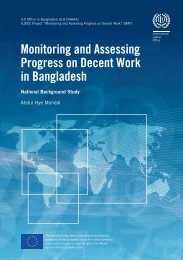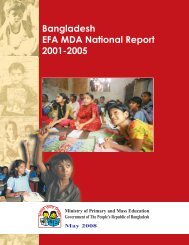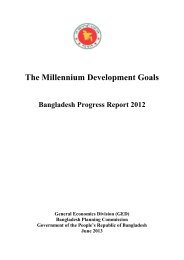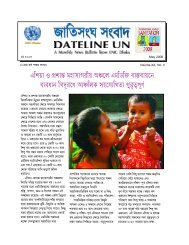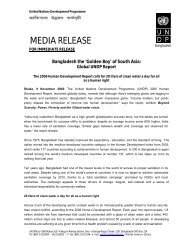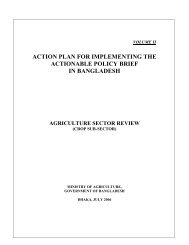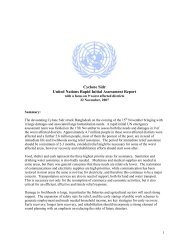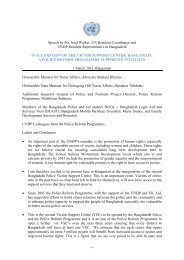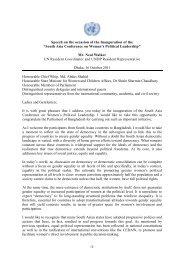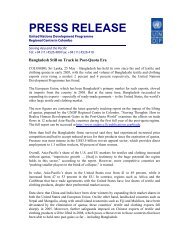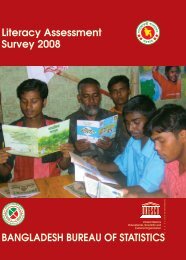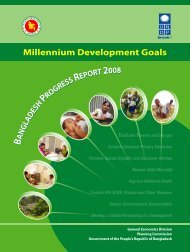Towards an Arsenic Safe Environment in Bangladesh - Unicef
Towards an Arsenic Safe Environment in Bangladesh - Unicef
Towards an Arsenic Safe Environment in Bangladesh - Unicef
- No tags were found...
You also want an ePaper? Increase the reach of your titles
YUMPU automatically turns print PDFs into web optimized ePapers that Google loves.
INTRODUCTIONIt was thought that B<strong>an</strong>gladesh had succeeded <strong>in</strong> offer<strong>in</strong>g safe dr<strong>in</strong>k<strong>in</strong>gwater to the vast majority of its population through tube wells with h<strong>an</strong>dpumps by the early 1990s. However, dur<strong>in</strong>g the same decade this success waschallenged by the discovery of widespread arsenic contam<strong>in</strong>ation exceed<strong>in</strong>gthe B<strong>an</strong>gladesh dr<strong>in</strong>k<strong>in</strong>g water st<strong>an</strong>dard of 50 microgram per liter. Severalscreen<strong>in</strong>g campaigns have determ<strong>in</strong>ed the extent <strong>an</strong>d severity of arseniccontam<strong>in</strong>ation. Tens of millions of people were at risk, reduc<strong>in</strong>g the safewater coverage of B<strong>an</strong>gladesh from nearly universal to about 80%. TheGovernment of B<strong>an</strong>gladesh together with stakeholders have undertaken ar<strong>an</strong>ge of arsenic mitigation strategies guided by the National Policy for<strong>Arsenic</strong> Mitigation issued <strong>in</strong> 2004, <strong>an</strong>d the Implementation Pl<strong>an</strong> for <strong>Arsenic</strong>Mitigation. Both the public <strong>an</strong>d the private sectors have made signific<strong>an</strong>tprogress towards mitigation.The Government ofB<strong>an</strong>gladesh electedon J<strong>an</strong>uary 6, 2009committed <strong>in</strong> itselection m<strong>an</strong>ifestothat the arsenicproblem will betackled <strong>an</strong>dmeasures will betaken to ensurethe supply of safedr<strong>in</strong>k<strong>in</strong>g water forall by 2011.However as of 2009 this problem is far from solved, jeopardiz<strong>in</strong>g theprogress towards achiev<strong>in</strong>g the Millennium Development Goals. Despitemassive efforts to provide safe water supplies <strong>in</strong> arsenic-affected areas, awater quality survey <strong>in</strong> 2009 by the B<strong>an</strong>gladesh Bureau of Statistics <strong>an</strong>dUNICEF has found that 12.6% of dr<strong>in</strong>k<strong>in</strong>g water samples collected from13,423 households around the country do not meet the B<strong>an</strong>gladesh dr<strong>in</strong>k<strong>in</strong>gwater st<strong>an</strong>dard for arsenic (Figure 1). This is equivalent to approximately 20million people still be<strong>in</strong>g exposed to excessive qu<strong>an</strong>tities of arsenic. Recentknowledge of the health threats posed by arsenic, as well as evidence ofarsenic penetration <strong>in</strong>to the food cha<strong>in</strong> make urgent action absolutelyessential. In recognition of the cont<strong>in</strong>u<strong>in</strong>g challenge posed by arsenic, thepresent Government of B<strong>an</strong>gladesh committed <strong>in</strong> its election m<strong>an</strong>ifesto that“the arsenic problem will be tackled <strong>an</strong>d measures will be taken to supplydr<strong>in</strong>k<strong>in</strong>g water for all by 2011.” This document stresses the urgency of thesituation <strong>an</strong>d recommends key actions to be taken to achieve this goal.



